MSI GE60 Review: Mainstream Mobile Maxwell
by Jarred Walton on July 17, 2014 5:00 AM ESTMSI GE60 LCD: Surprisingly Good
I'll be honest: before actually seeing the GE60 in person, I wasn't expecting too much from the display. It's not that MSI has a reputation for using terrible LCD panels in their laptops, but the GT70 as one example is still sporting a TN panel even on the latest version. Thus, I was more than a little surprised to find that "lesser" GE60 using a Samsung PLS display, and while the out-of-box color accuracy could still be improved quite a bit, post-calibration the display performs exceptionally well. And even if you're not a stickler for accurate colors, the improved viewing angles offered by PLS/IPS/AHVA/etc. panels make using the laptop much more viable in cramped quarters (e.g. on a plane).
Full results for the display testing are in Notebook Bench, as well as in the galleries below; the charts mostly reflect the highlight right now (as we haven't tested very many laptops with the new software/hardware). But let's start with the core characteristics: white level, black level, and contrast.
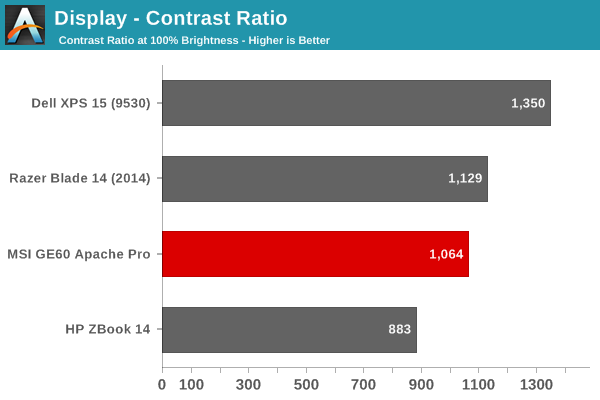
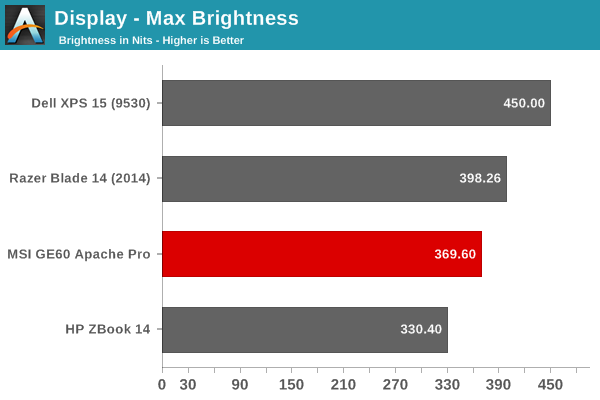
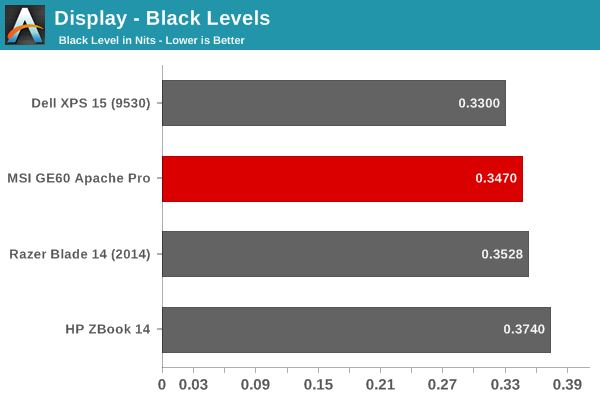
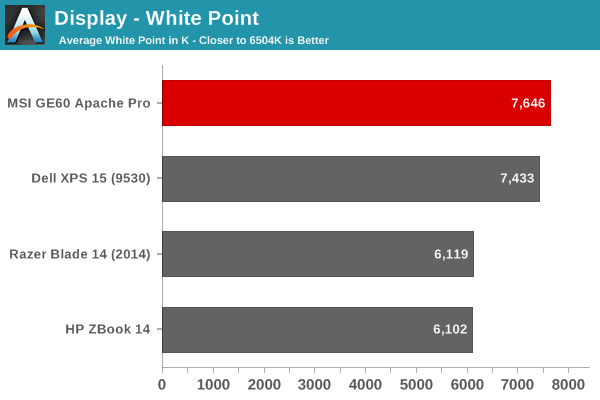
The white level of 370 cd/m2 is a good starting point, and with a black level of 0.3472 nits at max brightness we end up with a contrast ratio of 1064:1. That's not the best result that we've ever seen from a laptop, but it is quite good – even more so considering the display has an anti-glare coating (glossy displays tend to have a bit higher contrast). Dropping the brightness to 54% gives us a 200 nits white level with a 1016:1 contrast, so it's a bit lower but still good. The problem is the native white point is around 7650K, which is far from the "ideal" 6504K, so there's a definite blue tint to the colors. That brings us to the full uncalibrated results:

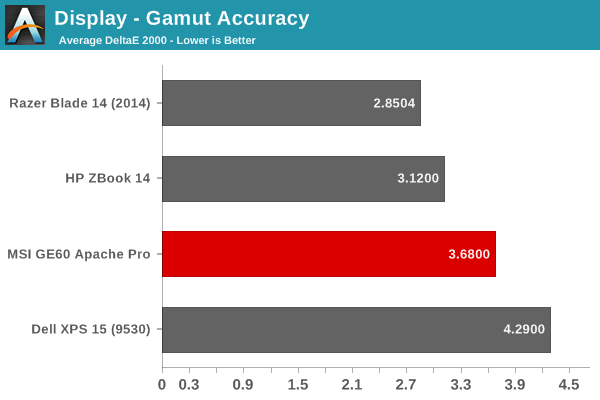


Grayscale results are good up until about 40%, at which point the errors start to become visible. By 50% the Delta E has increased to over 5, and by 75% dE is nearly 10. That's really not a very good result, though I've certainly seen worse (e.g. MSI's GT70 LCD had errors above 12 before calibration). Results in the other charts tell a similar story. While the average dE may only be in the range of 4.5 or so, there are many spikes into the high single digits – mostly in the reds, oranges, and yellows, but shades of green a blue also show some significant errors.
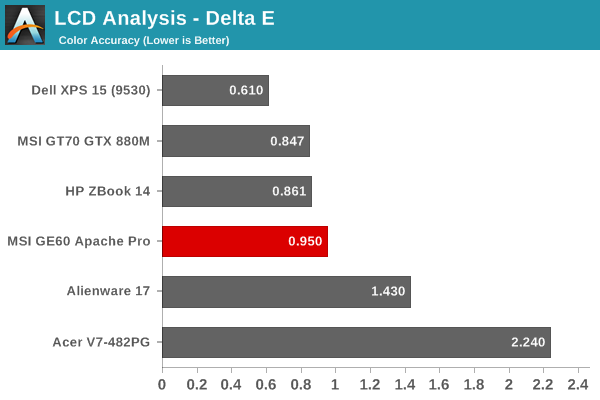
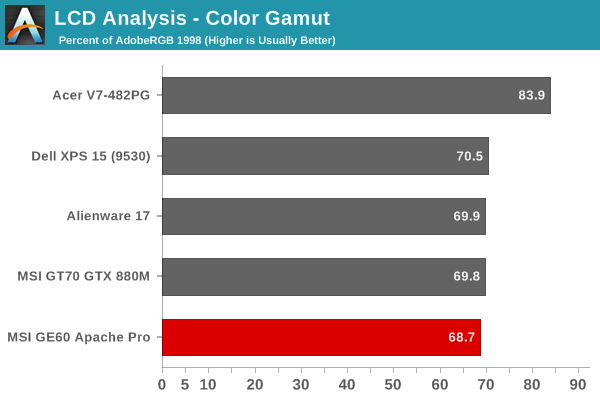
Post-calibration is a different story; the gamma, RGB balance, and color accuracy improve dramatically, to the point where there are very few errors even reaching 2.0. If you have the proper tools to calibrate the display, the GE60 can definitely suffice for professional work. The color gamut is also pretty close to the sRGB standard (it's 68.7% of AdobeRGB compared to a 72% target for sRGB), so outside of users who need high color depth it will work well.



























63 Comments
View All Comments
Flunk - Thursday, July 17, 2014 - link
I totally agree with you. I'd rather have a better experience typing than extra number buttons I'm not going to use all that often. If this was a business PC for accounting, perhaps the number pad would make sense.DanNeely - Thursday, July 17, 2014 - link
For everything work related except spreadsheeting, I'd rather have the arrows and navigation keys in the standard 104 key positions instead of smashed into the edge of the main area and scattered at random as fn-combos.JarredWalton - Thursday, July 17, 2014 - link
I use a 10-key enough that I'm happier with a full 104-key arrangement rather than 2-inch gaps on the right and left where keys could have been but aren't in the interest of centering the keyboard. YMMV.nathanddrews - Friday, July 18, 2014 - link
Indeed. I use the 10-key a lot for work and some games.Antronman - Thursday, July 17, 2014 - link
It's a gaming laptop, and some very popular games have mods or themselves take advantage of the numpad.Nagorak - Wednesday, July 23, 2014 - link
I use my numpad all the time. If the GE60 did not have a numpad I definitely would have had a hard time justifying my purchase of it.Khenglish - Thursday, July 17, 2014 - link
Have you looked at the W230ss? 13.3" clevo with 860m and 3200x1800 screen option.While it has a smaller screen, it's fatter than the MSI since clevo packed in the giant 12.7cfm fan that they use for GPU cooling on their bigger laptops.
emarston - Thursday, July 17, 2014 - link
I have the GE70 version... popped in 2 840 EVOs in raid (1TB drive as mass storage only) and it is quite nice. It can get warm, but being a bigger chassis and using a laptop cooler have totally removed any issues with that for me. With the SSD performance difference is dramatic.MooseMuffin - Thursday, July 17, 2014 - link
I realize you need to use certain configurations so you have points of comparison with other machines you've reviewed, but framerates at the display's native resolution are the only ones that really matter.evilspoons - Thursday, July 17, 2014 - link
It's weird, the lead-in for the page with gaming results talks about 1920x1080 (the panel's native res) but then I don't see any charts for that resolution. It's like they were left out by accident.On the other hand, if you dive into the control panel for your video card and enable "aspect ratio scaling on GPU" instead of the default scaling on screen, the jaggies tend to be MUCH less horrible when operating below native resolution.